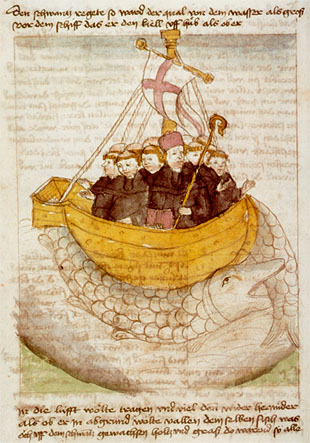
Brendan of Clonfert is one of the early Irish monastic saints and one of the Twelve Apostles of Ireland. He is also referred to as Brendan the Navigator, Brendan the Voyager, Brendan the Anchorite, and Brendan the Bold. The Irish translation of his name is Naomh Bréanainn or Naomh Breandán. He is mainly known for his legendary voyage to find the “Isle of the Blessed” which is sometimes referred to as “Saint Brendan’s Island”. The written narrative of his journey comes from the immram The Navigatio Sancti Brendani Abbatis.

Tuam is a town in Ireland and the second-largest settlement in County Galway. It is west of the midlands of Ireland, about 35 km (22 mi) north of Galway city. Humans have lived in the area since the Bronze Age while the historic period dates from the sixth century. The town became increasingly important in the 11th and 12th centuries in political and religious aspects of Ireland. The market-based layout of the town and square indicates the importance of commerce.

June 5 - Eastern Orthodox Church calendar - June 7

Nath Í, or Crumnathy, was an early Irish saint who was remembered as the founder of Achonry.

Colmán of Cloyne, also Colmán mac Léníne, was a monk, founder and patron of Cluain Uama, now Cloyne, County Cork, Ireland, and one of the earliest known Irish poets to write in the vernacular.

The Twelve Apostles of Ireland were twelve early Irish monastic saints of the sixth century who studied under St Finnian at his famous monastic school Clonard Abbey at Cluain-Eraird, now Clonard in County Meath.

Secundinus, or Sechnall as he was known in Irish, was founder and patron saint of Domhnach Sechnaill, County Meath, who went down in medieval tradition as a disciple of St Patrick and one of the first bishops of Armagh. Historians have suggested, however, that the connection with St Patrick was a later tradition invented by Armagh historians in favour of their patron saint and that Secundinus is more likely to have been a separate missionary, possibly a companion of Palladius.
Saint Colmán mac Luacháin was an early Irish abbot, founder and patron saint of Lann.
Eithne and her sister Sodelb are two relatively obscure Irish saints from Leinster who are supposed to have flourished in the 5th century. They are commemorated together in the Irish martyrologies on 29 March, though 2 and 15 January were also marked out as feast-days. The 17th-century scholar John Colgan believed that a Life written for them had been witnessed in c. 1490 by Cathal Óg Mac Maghnusa, whom he regarded as the author of additions to the Félire Óengusso. Although nothing of the kind has come to light, they do make cameo appearances in the Lives of two better-known 6/7th-century saints, Áedan and Moling, both bishops of Ferns.
Lommán mac Dalláin was a saint and patron of Trim, County Meath in Ireland.
Annaghdown is a civil parish in County Galway, Ireland. It lies around Annaghdown Bay, an inlet of Lough Corrib. Villages in the civil parish include Corrandulla and Currandrum. Annaghdown is also an ecclesiastical parish in the Roman Catholic Archdiocese of Tuam and the Church of Ireland Diocese of Tuam, Killala and Achonry.
Áed Ua hOissín was consecrated first Archbishop of Tuam in 1152 and died in 1161. He was closely associated with Connacht royalty, and had served as abbot of Tuam.
John de Burgh, or de Burgo, or Burke was an Irish Roman Catholic clergyman who served as Vicar Apostolic (1629–41) and Bishop (1642–47) of Clonfert, and Archbishop of Tuam (1647–67).
Maolán was an early Christian bishop in Connacht, whose feast day is given as 25 December. He is the reputed founder of a church at Tullaghmelan in County Tipperary.

Declán of Ardmore, also called Déclán, was an early Irish saint of the Déisi Muman, who was remembered for having converted the Déisi in the late 5th century and for having founded the monastery of Ardmore in what is now County Waterford. The principal source for his life and cult is a Latin Life of the 12th century. Like Ailbe of Emly, Ciarán of Saigir and Abbán of Moyarney, Declán is presented as a Munster saint who preceded Saint Patrick in bringing Christianity to Ireland. He was regarded as a patron saint of the Déisi of East Munster.
Iarlaithe mac Treno was the Bishop of Armagh, Ireland from 468 to 11 February 481.

Kilbennen or Kilbannon is a medieval ecclesiastical site and National Monument located in County Galway, Ireland.

The Diocese of Tuam, Limerick and Killaloe is a diocese of the Church of Ireland that is located in the west of Ireland. The diocese was formed by a merger of the former Diocese of Tuam, Killala and Achonry and the former Diocese of Limerick and Killaloe in 2022, after the retirement of the separate dioceses' bishops and the appointment of Michael Burrows as bishop of the united diocese. It is in the ecclesiastical province of Dublin. It is one of the eleven Church of Ireland dioceses that cover the whole of Ireland. The largest diocese by area in the Church of Ireland, it covers all of counties Clare, Galway, Kerry, Limerick and Mayo, plus parts of counties Cork, Sligo, Roscommon, Offaly, Laois and Tipperary.












